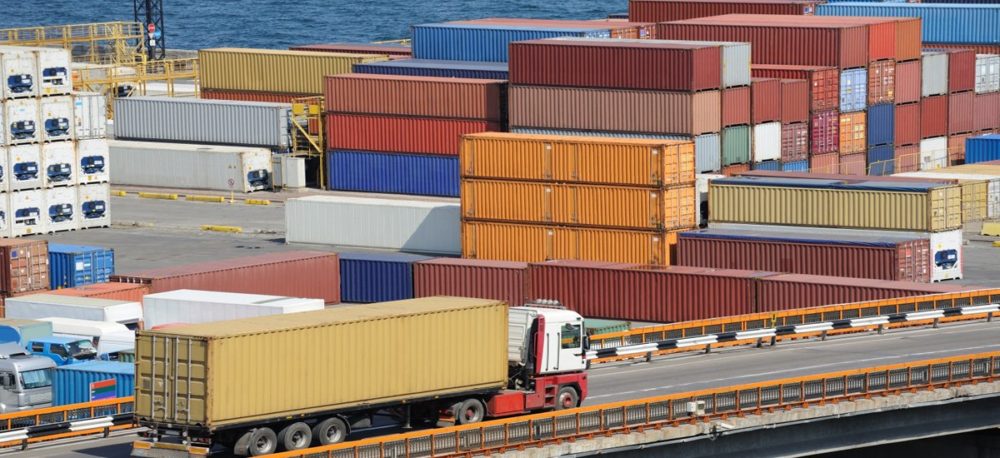Sustainable freight. Almost sounds like an oxymoron, especially to anyone that lives near a truck route, port, or warehouse. How can a system of trains, ships, planes, and trucks designed to move billions of dollars’ worth of goods from factories around the world to your doorstep be “sustainable”?
Despite that challenge, California officials released a draft Sustainable Freight Action Plan—a multi-agency effort resulting from Governor Brown’s Executive order issued last July—aimed at taking steps to transform the freight system to address the challenges of poor air quality and climate change. There’s some good stuff in the plan, but some room for improvement too.
What is the California Sustainable Freight Action Plan?
The plan is the result of a collaboration among multiple state agencies, including the agency that sets and enforces regulations to clean our air (the Air Resources Board) and those who build and maintain our roads and infrastructure (Caltrans). It is “an unprecedented effort, intended to integrate investments, policies, and programs across several State agencies to help realize a singular vision of California’s freight transport system.”
The Vision proposed by the agencies is as follows:
Utilize a partnership of federal, state, regional, local and industry stakeholders to move freight in California on a modern, safe, integrated, and resilient system that continues to support California’s economy and livability. Transporting freight reliably and efficiently by zero emissions equipment everywhere feasible and near zero emissions equipment powered by clean, low-carbon renewable fuels everywhere else.
Among the several items included in the plan is a commitment to deploy 100,000 freight vehicles and equipment capable of zero emission operation by 2030, a target for improving the overall efficiency of the freight system, and the identification of 3 near-term pilot projects for the agencies to jointly pursue.
Why is this important?
Transportation of freight remains one of the largest sources of air pollution in California, accounting for nearly half of smog-forming nitrogen oxide emissions and diesel particulate emissions. Freight also accounts for 6 percent of the state’s global warming emissions and is growing as freight volumes increase and other polluting sources get cleaner.
To address this problem, good coordination of state agencies is critical. The Air Resources Board is crafting regulations to put us on track to meeting air quality standards and climate goals, the Energy Commission is investing in cleaner fuels and vehicle technology advancement, Caltrans is making decisions about road, highway and other infrastructure projects that have lifetimes of 50 years or more, and Go-Biz is aiming to keep California’s economy going strong. The efforts of these agencies need to be coordinated so their decisions are aimed toward a common goal.
While there are many important components to the plan, there are several areas where it could be improved. Here are just two.

The California Air Resources recently announced a $24 million grant to deploy more than 40 heavy-duty trucks with electric drive capabilities for operation at ports around the state. (Photo of a battery electric tractor courtesy of Transpower)
Zero Emission Technology Deployment
Deploying electric truck and freight technologies is a critical step toward a more sustainable freight system, and committing to their deployment is an important step. However, the wide range of equipment—from small refrigeration units on trucks and shipping containers, to forklifts, airport baggage handling equipment, all the way to tractor trailers—makes such a broad commitment less effective than it could otherwise be. The plan should more specifically commit to deployment of zero emissions vehicles that are of primary concern to impacted communities and prioritize the deployment of the 100,000 zero emission vehicles or pieces of equipment in communities most impacted by freight.
Drayage trucks are a good example. These trucks transport shipping containers between warehouses, railyards, and ports and are therefore operating in communities around these facilities. However, the plan does not include the pursuit of any future regulatory measures to accelerate the deployment of electric drayage trucks despite the fact that millions of dollars are being invested in demonstrating these technologies today.
Finally, deploying 100,000 pieces of electric freight equipment will take infrastructure to power and fuel them (electricity or hydrogen). But the Public Utilities Commission, the state’s utility regulator, is not a party to the freight action plan. Smart utility policy is going to be key to ensuring truck and freight electrification is successful—from setting rate plan designs that are conducive to electrification, to ensuring utilities are providing the support necessary for fleets to incorporate electric technologies into their operations. The CPUC should be a partner agency in implementing the Sustainable Freight Action Plan and share the same vision as the other signatory agencies.
Making the freight system sustainable and equitable
In reading the proposed Vision statement (above), there is no mention of creating an equitable freight system—one where the impacts are not disproportionately borne by low-income communities and communities of color as they are today. This is a glaring omission for a plan intended to achieve a “sustainable” freight system.
Freight-impacted communities have the most at stake. Deployment of zero emission technologies and effective enforcement of current regulations should be targeted in these communities and the plan should include a goal to address freight pollution hotspots. These are critical steps in addressing the current inequities of the freight transportation system.
While a truly sustainable freight system may be ways off, taking the steps to get us on the right path now is essential. A final Sustainable Freight Action Plan that puts communities first and captures a vision of a freight system that is both equitable and sustainable would be a great early step on the long road to transforming how we move goods in California and ultimately around the globe.
Featured photo: US Dept. Transportation

